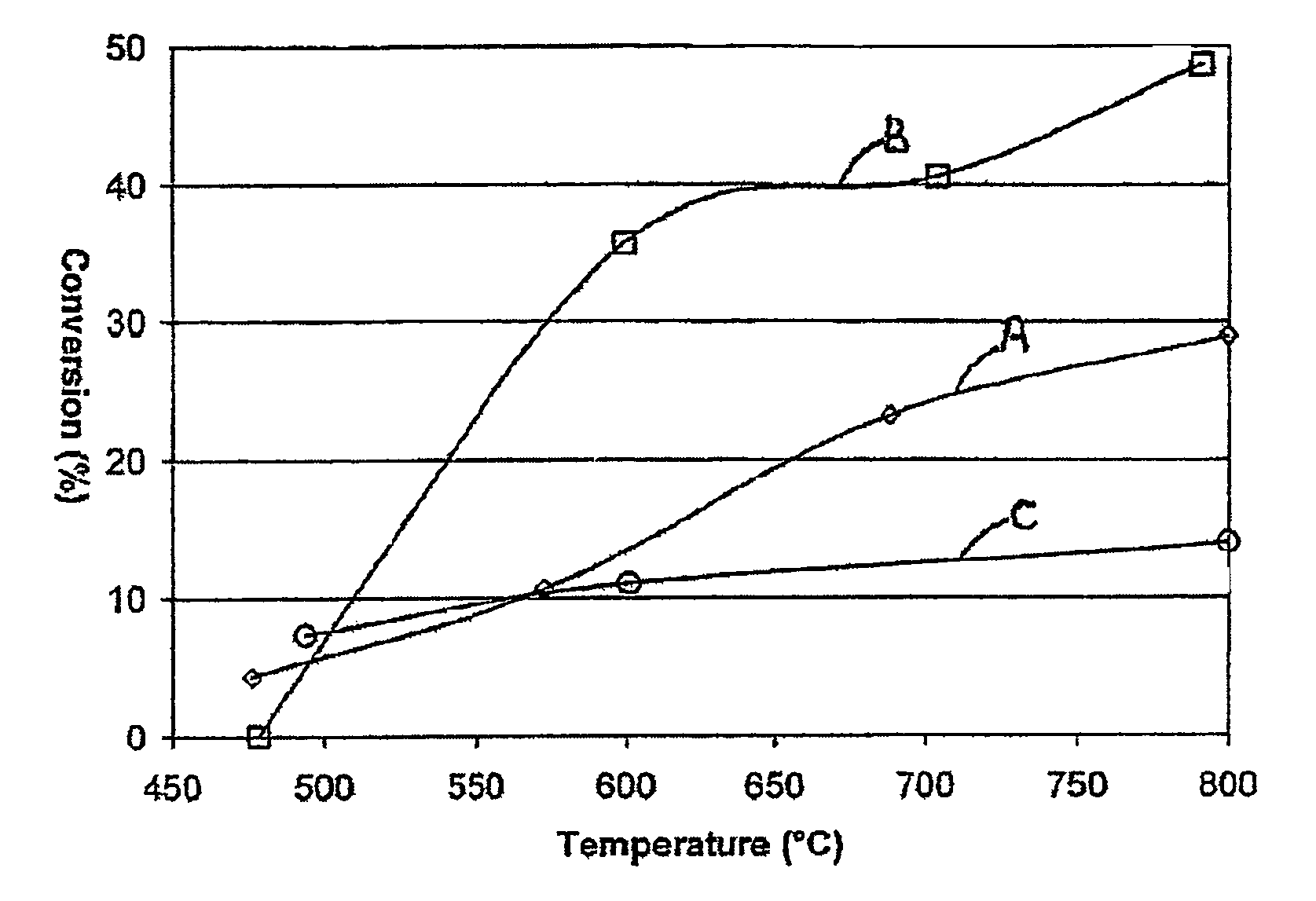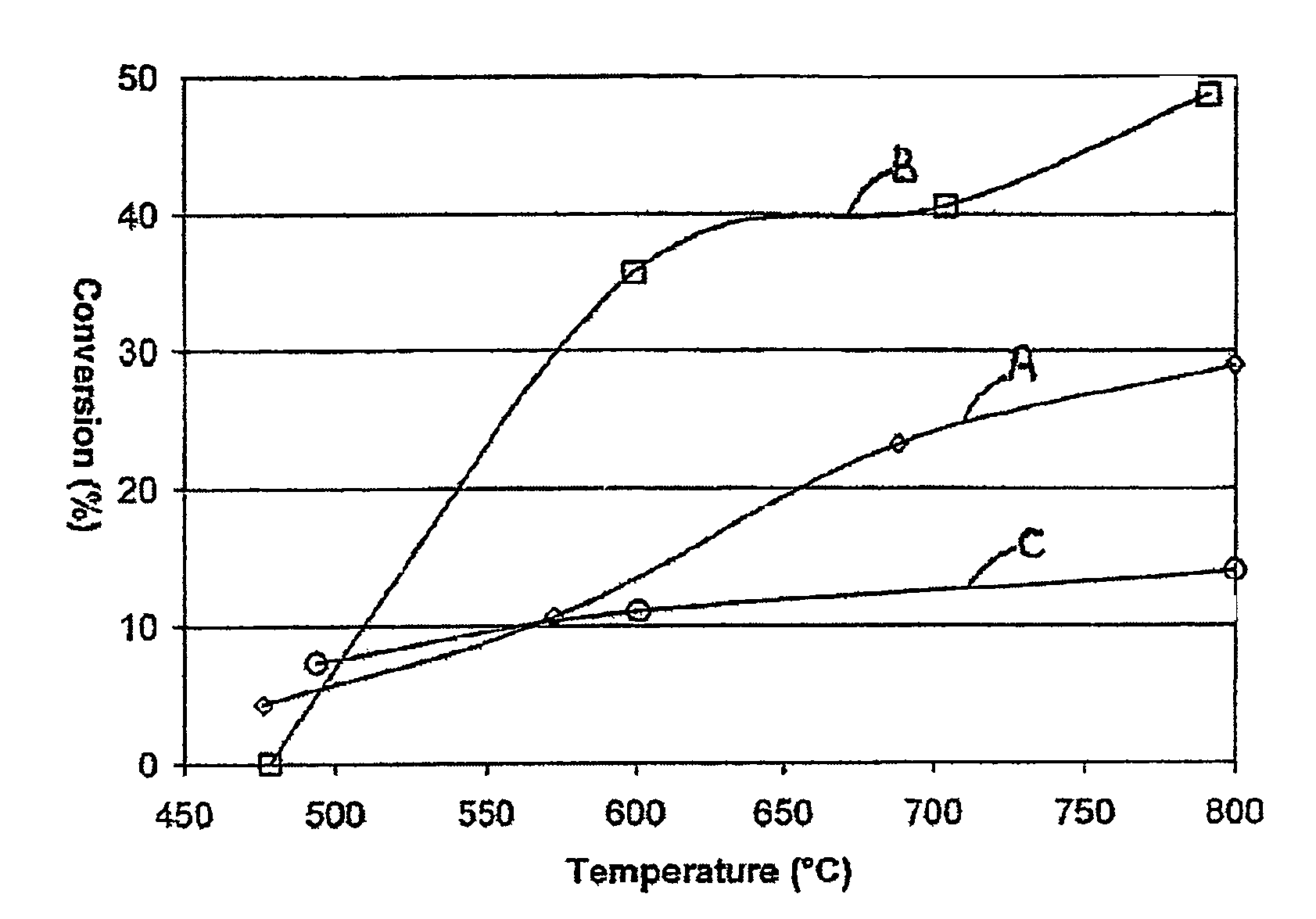Catalyst charge design
a catalyst and charge technology, applied in the field of improved, can solve the problems of limited commercial scale applications, undesirable residual ammonia, and difficulty in recovering platinum, and achieve the effects of high surface area, easy manufacturing, and enhanced thickness
- Summary
- Abstract
- Description
- Claims
- Application Information
AI Technical Summary
Benefits of technology
Problems solved by technology
Method used
Image
Examples
example
Example 1
Preparation of Second Stage Catalyst Samples
[0056]A. 0.1 wt % Rh was impregnated into commercial porous gamma-alumina Raschig rings (available e.g. from Saint-Gobain Norpro) using conventional catalyst preparation techniques, the samples dried and fired, and the sample crushed and sieved to a particle size range between 250 and 355 microns;[0057]B. A crushed sample of 0.2 wt % Rh on identical rings as in sample A was prepared in analogous manner;[0058]C. A standard washcoating technique was used to apply a powdered 0.5 wt % Rh on alumina catalyst onto highly macroporous alpha-alumina ceramic Raschig rings. The samples were dried, fired and crushed as in Sample A. The final loading of Rh on the coated product was 0.03% by wt.
[0059]A single 95%Pt5%Rh knitted gauze was used to catalyse a feed stream of 10% NH3 in air to produce a first stage product comprising NOx, N2O, steam, nitrogen, and unreacted NH3 and oxygen. The first stage product was passed directly into a second rea...
example 2
[0060]A large number of tests were performed in a high throughput parallel reactor on a variety of metal or metal oxide catalysts carried on a variety of commercially available and proprietary oxidic supports, including mixed oxide supports, and made in conventional manner. Testing for N2O decomposition led to the following conclusions:[0061]1. Supported base metal oxide catalysts have low activity, although Ni, preferably Ni on CeO2, was the most active;[0062]2. For PGM catalysts, at equivalent loadings, Pd>Ir>>Ru or Pt;[0063]3. Mixed PGM catalysts offer little to negative benefit over single PGM metal catalysts;[0064]4. Addition of other metals tends to degrade the performance of Rh;[0065]5. The absolute activity of Rh catalysts is support dependent, with alumina or ceria / alumina / zirconia being the best; and[0066]6. At “high” loadings (>5%), Pt and Ru show reasonable activity.
example 3
[0067]The highest activity N20 destruction catalyst from Example 2, 0.5% Rh on alumina, was compared with a LaCeCo oxide catalyst prepared according to WO 98 / 28073, in a representative gas comprising NOx, oxygen and water vapour, at various temperatures, both “fresh” and after hydrothermal aging at 1000° C. in air, to represent a used catalyst. The fresh Rh catalyst showed the best performance from about 500° C., reaching 100% conversion at about 800° C., however, even the aged LaCeCo oxide catalyst showed greater than 90% conversion at 900° C.
PUM
| Property | Measurement | Unit |
|---|---|---|
| temperature | aaaaa | aaaaa |
| temperature | aaaaa | aaaaa |
| temperatures | aaaaa | aaaaa |
Abstract
Description
Claims
Application Information
 Login to View More
Login to View More - R&D
- Intellectual Property
- Life Sciences
- Materials
- Tech Scout
- Unparalleled Data Quality
- Higher Quality Content
- 60% Fewer Hallucinations
Browse by: Latest US Patents, China's latest patents, Technical Efficacy Thesaurus, Application Domain, Technology Topic, Popular Technical Reports.
© 2025 PatSnap. All rights reserved.Legal|Privacy policy|Modern Slavery Act Transparency Statement|Sitemap|About US| Contact US: help@patsnap.com



